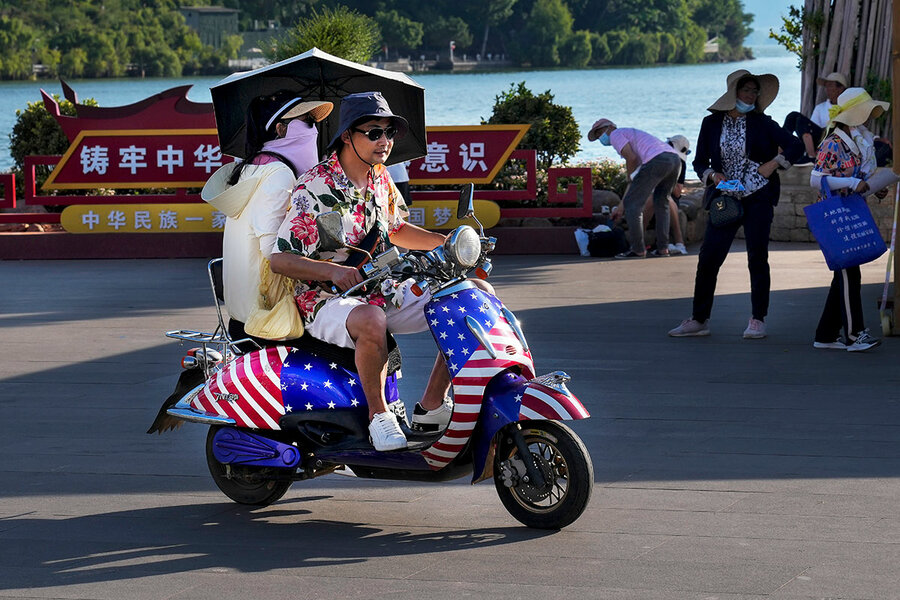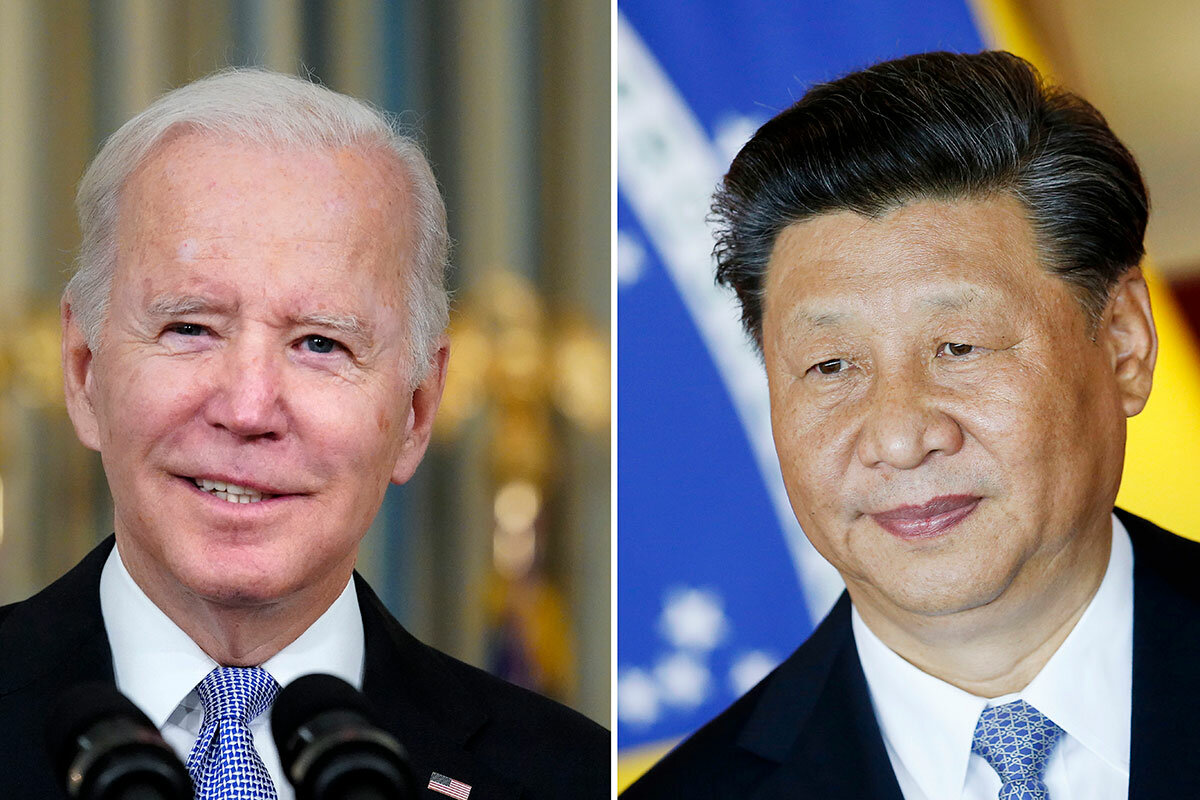Hello? Hello? Washington finds it hard to get through to Beijing.
Loading...
| London
What the world needs now is a new Cold War.
That might sound crazy, but at least the rules of that war, the intricate shared architecture of state-to-state interaction and crisis management that Washington and Moscow built together, largely kept the peace and prevented a “hot” war.
Why We Wrote This
The poor state of Beijing’s communications with Washington is making some U.S. officials nostalgic for the Cold War, when shared rules kept the peace with Moscow.
But no such habits of communication have developed between the United States and its new superpower rival, China. There are no guardrails to prevent their competition from degenerating into conflict.
President Joe Biden and his senior officials have been trying to persuade Chinese leader Xi Jinping to start talking about practical ways in which the two countries might ensure strategic stability, but they have not had much success.
Mr. Biden will take up the issue tomorrow, in a phone call with Mr. Xi, not least because tensions around Taiwan, which Beijing regards as part of its territory, have risen sharply. The Chinese government is furious with U.S. House Speaker Nancy Pelosi’s reported plan to visit Taiwan, and the White House is not keen on it, either.
Such spats would be easier to manage if Washington and Beijing enjoyed robust avenues of communication that might offer mutual understanding. At the moment, the relationship is dangerously opaque.
What the world needs now is a new Cold War.
Yes, you read that right.
And jarring though it will sound to those who remember Cold War I, it is that thought that is motivating intensified U.S. efforts to prevent a contentious relationship with China from becoming steadily – perhaps dangerously – worse.
Why We Wrote This
The poor state of Beijing’s communications with Washington is making some U.S. officials nostalgic for the Cold War, when shared rules kept the peace with Moscow.
This is not about pining for a reprise of the U.S-Soviet Cold War. It is simply acknowledging that Washington and Beijing are already locked in superpower competition, but they lack Cold War-style “guardrails” around their rivalry to prevent it from breaking down into hot war.
What’s still largely missing from the U.S.-China relationship is what might be called the “good” part of the old Cold War: the intricate shared architecture of state-to-state interaction and crisis management built up with Moscow; the arms talks and hotlines; the latticework of political and diplomatic and military exchanges; the regular summits and other high-level meetings that preserved the peace.
A reliable fabric of frank, forthright communication.
With Moscow, that had the long-term aim of narrowing differences. But it had a more immediate, practical objective: to ensure that each superpower adversary understood the other’s thinking and its “red lines” well enough to avoid potentially dangerous miscalculations, and an accidental escalation.
The absence of such understanding and trust when it comes to China has been worrying President Joe Biden since he entered the Oval Office 18 months ago. He and his top officials have been pressing Beijing to begin building crash barriers around their competition to stop it from degenerating into conflict.
But there’s been little sign of progress so far. And as Mr. Biden prepares for a phone call with Chinese leader Xi Jinping on Thursday, with an eye to a possible in-person meeting in November, a number of factors have ramped up his administration’s urgent search for ways to reduce the chance of potential miscalculations on either side.
The immediate issue is the democratic island state of Taiwan, which Mr. Xi is on record as saying will eventually be “reunified” with mainland China, by force if necessary.
For the last few months, Washington’s overriding focus on the Ukraine war has overshadowed its concern over Taiwan. The hope has been that Russian President Vladimir Putin’s failure to win a lightning victory in Ukraine might give Mr. Xi pause in considering any military action of his own.
That may well be true.
U.S. officials have been encouraged by the Chinese leader’s response to Mr. Biden’s explicit request in March that he show restraint on Ukraine. There are no signs that China has helped resupply Mr. Putin’s military, and major Chinese businesses have largely abided by Western sanctions against Moscow.
There was also a symbolic show of superpower amity in recent days: Mr. Xi responded to the announcement that Mr. Biden had tested positive for COVID-19 by wishing him a speedy recovery.
Still, the Chinese military has recently been far more assertive in confrontations with U.S. naval patrols exercising their right to sail in the South China Sea, which Mr. Xi has unilaterally claimed as Chinese territory.
And on Taiwan, there’s a new, potentially fractious, point of dispute: reported plans by U.S. House Speaker Nancy Pelosi to make an official visit to Taiwan next month – prompting Chinese Foreign Ministry spokesperson Zhao Lijan to vow “firm and forceful measures” if the trip goes ahead.
Though ultimately the decision on whether to go rests with Ms. Pelosi, the White House has made clear it would be happier if she delayed the trip.
One key reason is a potentially unpredictable political context inside China itself.
Mr. Xi’s attention is focused on a Communist Party congress in the fall, at which he is widely expected to secure an unprecedented third term in power. The concern among U.S. experts is that, especially at a time when Mr. Xi’s pandemic restrictions have led to a slowdown in economic growth, he might be more likely to indulge in a show of military assertiveness against Taiwan.
President Biden’s conversation with Mr. Xi tomorrow may clarify some of these uncertainties. Other long-standing issues of contention, such as whether Mr. Biden may start to ease his predecessor’s trade sanctions against China, could also come up.
But the new dispute over Taiwan has served to reinforce U.S. concern over the more fundamental problem in the relationship with China: its opaqueness, and the lack of sufficiently robust avenues of communication to offer mutual understanding amid inevitable points of disagreement.
Mr. Biden is almost certain to make that case again in his talks with Mr. Xi. One indication of potential progress would be an agreement to open talks on “strategic stability” between the rival powers, which Washington sees as a foundation stone of a Cold War-type architecture of communication.
That could be a step toward the broader U.S. aim, which Mr. Biden first put directly to the Chinese leader late last year – a set of “commonsense” agreements to “ensure that competition does not veer into conflict.”








